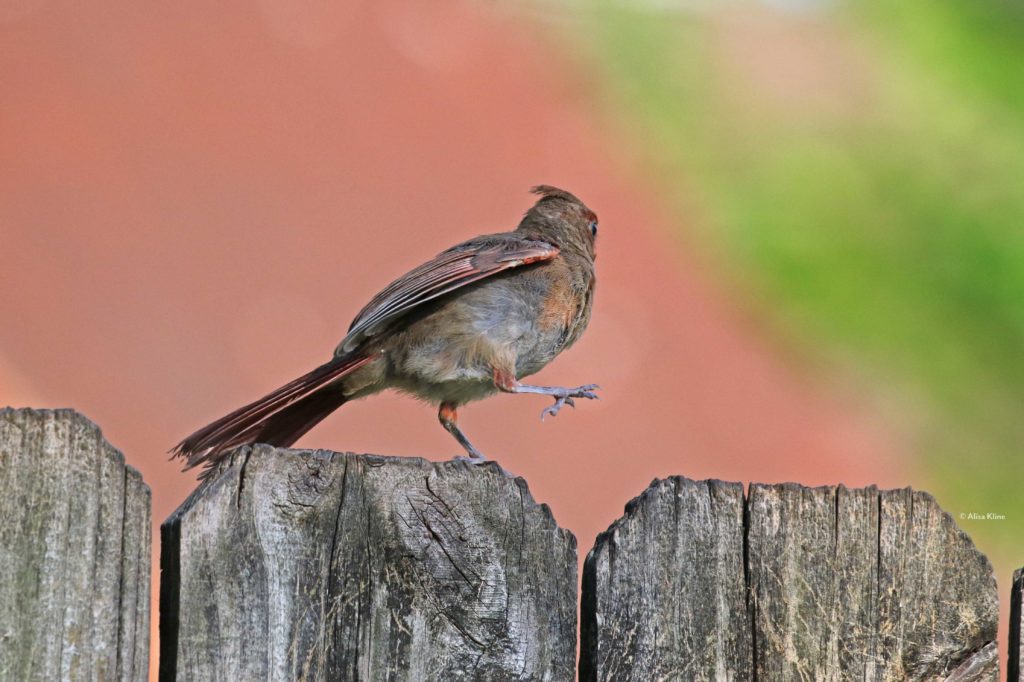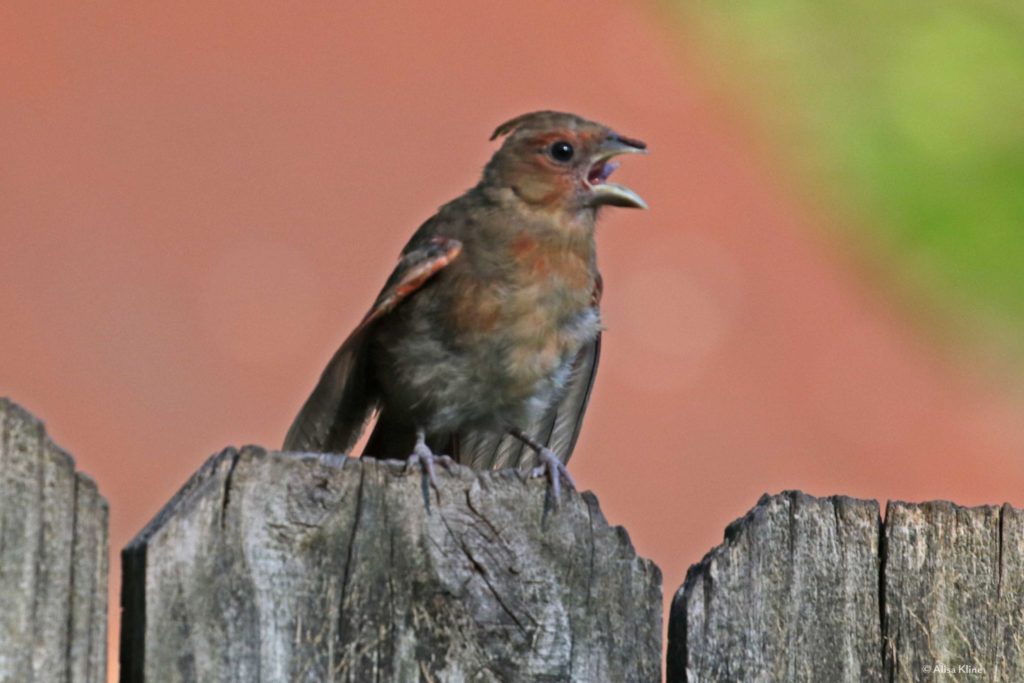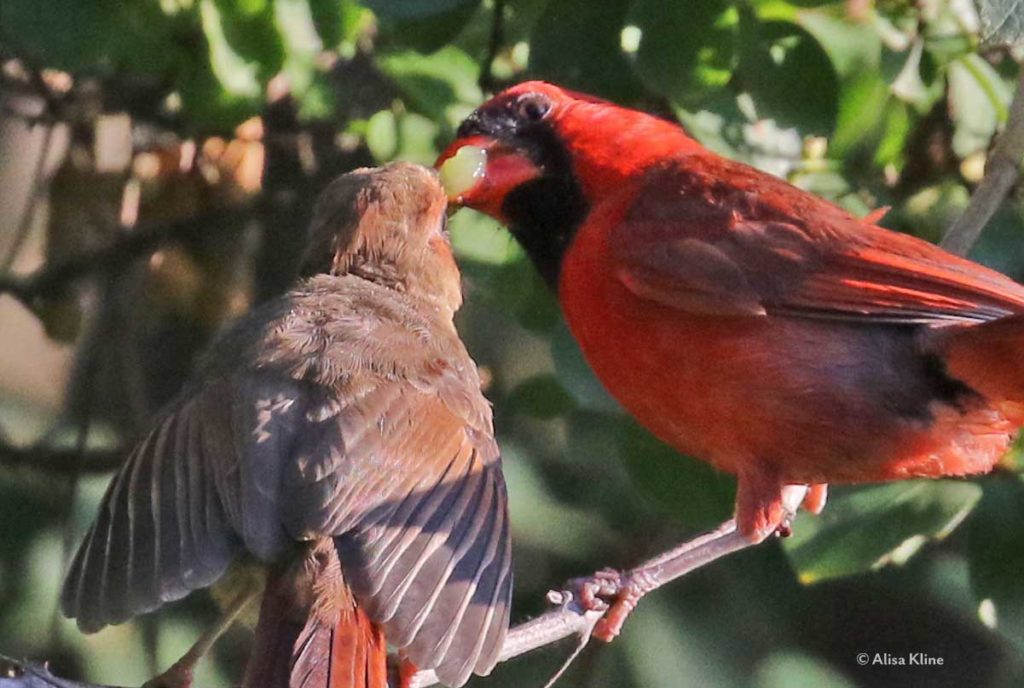World’s Best Dad

Cardinals have a special place in my heart. They are ubiquitous. Everywhere I have traveled in the U.S., I have been awoken by cardinal song. It is the same song I listened to in bed as a child and every time I hear it, I get a warm cozy feeling. Also, and I can’t really explain this, but female cardinals look like my mother. I think it was her lipstick. For years, her lips were the color of a female cardinal bill, a lovely peachy orange.
But even a species as familiar as my childhood memories holds mysteries. Or put another way, I know so little, I am constantly surprised by things that are really quite routine. Like how male cardinals (who do not in any way resemble my own father) are the world’s best dads! Ok, that is a bit like my own father.
That adorable little guy at the top of this post is a juvenile cardinal. You can tell by the mottled feathers. There is nothing unusual about this except that it is June. Cardinals start nesting in March, and by April, they have chicks. As I might have mentioned, it’s June. The chicks born in March and April do not look like this anymore. They look like full-grown birds. This little guy was probably hatched just a month ago.
I was, to say the least, perplexed by him. This baby seemed to be too young for June. Perhaps the first nest failed and this was a second effort. Maybe I was completely wrong about when cardinals nested. I realized I knew almost nothing at all about nesting cardinals. So I did a bit of research and immediately began to plumb the depths of my ignorance.

It’s a little blurry, but if you look close, that’s a baby cardinal tongue!
I had presumed, for absolutely no reason whatsoever, that birds mated, had a single brood and then went on with whatever the hell it is they do when not laboring over offspring. That’s sort of how mammals do it. But the amount of time it takes to get a mammal ready for independence is a heck of a lot longer than getting bird up and out. Birds are out of the nest within a few weeks of being hatched. They have to be fed for a few weeks longer, but the whole process from egg to independence can be handled in under two months.
Because birds raise their young so quickly, they can have multiple broods a season. Most of the common songbirds I checked out have two broods. Cardinals can have up to three. They manage this through a division of labor. Today’s little guy is likely from a second brood and given that it is only June and he is so well along in development, I imagine that there is time for a third-round if mom is up to it.
Cardinals pair for multiple seasons and often for life. She is the homemaker. Literally. Female cardinals build their nests by chewing on twigs so they become flexible and then wrapping them around herself to create the nest’s superstructure. She fills in with three other layers of increasing softness.

Dad is feeding junior a grape.
Dad is not very involved in nest making. He’s not the one who will be sitting in it. He will bring her nesting materials for her consideration and he will keep her fed as she builds the nest and sits on the eggs. But this is her domain.
Once the chicks hatch, dad helps feed the brood and mom. Within about 11 days, the babies will be out of the nest and hanging out on nearby branches. Roughly a day after the chicks have fledged and are all out of the nest, mom puts the chicks into dad’s care and takes off. If the pair has only one chick, mom will take off in about two weeks for a big brood, mom might hang around longer. She’s not going to the spa for a well-deserved break.
While dad takes care of feeding the first brood, mom gets busy building a second nest in which she will lay a second brood of eggs. This is a lot of work and she gets bonus points for dedication. But she really comes in second to dad in this regard. He may have taken it easy while she built that first nest and sat on the first brood, but now all the chicks and mom, who is sitting on a new bunch of eggs, are fed by dad who must be as busy as that proverbial one-armed paperhanger. That second brood will be hatching in about 11 days and then, dad will have to look after the first brood, who can expect at least some food until they’re almost three months old, mom, and the second brood of ravenous chicks. At least that first brood should be completely off his plate before that third set of mouths appears.
So let us celebrate those flashy red cardinals. Nature’s best dads.

